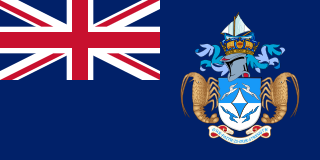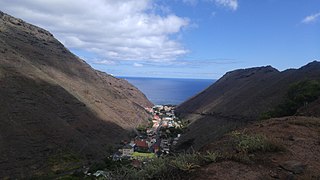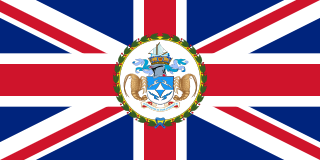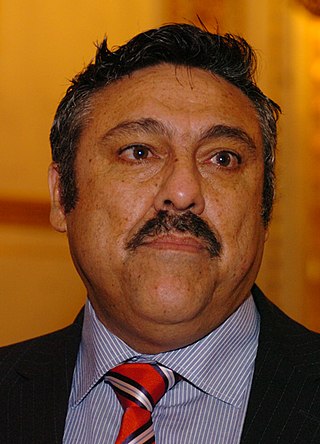
Saint Helena is one of the three constituent parts of Saint Helena, Ascension and Tristan da Cunha, a remote British overseas territory.

Saint Helena is an island in the South Atlantic Ocean, about midway between South America and Africa. St Helena has a land area of 122 square kilometres and is part of the territory of Saint Helena, Ascension and Tristan da Cunha which includes Ascension Island and the island group of Tristan da Cunha.
This article deals with traffic in Saint Helena, Ascension and Tristan da Cunha, that is all forms of traffic in the British overseas territory of Saint Helena, Ascension and Tristan da Cunha.

Tristan da Cunha, colloquially Tristan, is a remote group of volcanic islands in the South Atlantic Ocean. It is the most remote inhabited archipelago in the world, lying approximately 2,787 kilometres (1,732 mi) from Cape Town in South Africa, 2,437 kilometres (1,514 mi) from Saint Helena, 3,949 kilometres (2,454 mi) from Mar del Plata in Argentina, and 4,002 kilometres (2,487 mi) from the Falkland Islands.
Tristan da Cunha is part of the British overseas territory of Saint Helena, Ascension and Tristan da Cunha and has a history going back to the beginning of the 16th century. It was settled by men from military garrisons and ships, who married native women from Saint Helena and the Cape Colony. Its people are multi-racial, descended from European male founders and mixed-race and African women founders.

Jamestown is the capital city of the British Overseas Territory of Saint Helena, Ascension and Tristan da Cunha, located on the island of Saint Helena in the South Atlantic Ocean. It is also the historic main settlement of the island and is on its north-western coast. Before the development of the port at Rupert's Bay, it was the island's only port and the centre of the island's road and communications network. It was founded when colonists from the English East India Company settled on the island in 1659 and was briefly occupied by the Dutch East India Company in 1673 before being recaptured. Many of the buildings built by the East India Company in the 18th century survive and give the town its distinctive Georgian flavour.

Inaccessible Island is a volcanic island located in the South Atlantic Ocean, 31 km (19 mi) south-west of Tristan da Cunha. Its highest point, Swale's Fell, reaches 581 m (1,906 ft), and the island is 12.65 km2 (4.88 sq mi) in area. The volcano was last active approximately one million years ago and is now extinct.

Edinburgh of the Seven Seas is the only settlement on the island of Tristan da Cunha, a part of the British Overseas Territory of Saint Helena, Ascension and Tristan da Cunha in the South Atlantic Ocean. Locally, it is referred to as The Settlement or The Village.

The governor of Tristan de Cunha is the representative of the monarch in Tristan da Cunha, a constituent part of the British Overseas Territory of Saint Helena, Ascension and Tristan da Cunha. The governor is appointed by the monarch on the advice of the British government. The role of the governor is to act as the de facto head of state.

The following outline is provided as an overview of and topical guide to Tristan da Cunha:

Ascension Island is an isolated volcanic island, 7°56′ south of the Equator in the South Atlantic Ocean. It is about 1,000 miles (1,600 km) from the coast of Africa and 1,400 miles (2,300 km) from the coast of South America. It is governed as part of the British Overseas Territory of Saint Helena, Ascension and Tristan da Cunha, of which the main island, Saint Helena, is around 800 miles (1,300 km) to the southeast. The territory also includes the sparsely populated Tristan da Cunha archipelago, 2,300 miles (3,700 km) to the south, about halfway to the Antarctic Circle.

Lesbian, gay, bisexual and transgender (LGBT) rights in the British Overseas Territory of Saint Helena, Ascension and Tristan da Cunha have gradually evolved over the years. Discrimination on the basis of sexual orientation is banned in the entire territory through the Constitution Order 2009 and same-sex marriage has been legal on the islands since 2017.

Saint Helena, Ascension and Tristan da Cunha is a British Overseas Territory located in the South Atlantic and consisting of the island of Saint Helena, Ascension Island, and the archipelago of Tristan da Cunha. Its name was Saint Helena and Dependencies until 1 September 2009, when a new constitution came into force, giving the three islands equal status as three territories, with a grouping under the Crown.
Saint Helena, Ascension and Tristan da Cunha is a British Overseas Territory in the South Atlantic, consisting of the island of Saint Helena, Ascension Island and the archipelago of Tristan da Cunha including Gough Island. Their communications provision includes dedicated radio and television stations, and telecommunications infrastructure.

The Tristan da Cunha Island Council is the unicameral non-partisan legislature of the island of Tristan da Cunha in the Atlantic Ocean. The Island Council consists of the Administrator of Tristan da Cunha as the presiding officer, plus three appointed and eight elected members. At least one elected member of the council must be a woman.

Conrad Jack Glass is a Tristanian police inspector and civil servant who was Tristan da Cunha's former Chief Islander from 2007 to 2010. Glass is the first islander to have written a book about the island: Rockhopper Copper (2005).
Anne Green MBE is a Tristanian teacher, politician and public administrator from Tristan da Cunha, a remote island in the southern Atlantic Ocean that is part of the British overseas territory of Saint Helena, Ascension and Tristan da Cunha. She was the first woman to be elected Chief Islander and also the first woman to be Acting Administrator of the island.

This article describes education in Saint Helena, Ascension and Tristan da Cunha.
William Glass was a Scottish Corporal and settler. He established the settlement that would become Edinburgh of the Seven Seas, the main settlement on Tristan da Cunha.
St. Mary's Church is a religious building belonging to the Church of England in the town of Edinburgh of the Seven Seas on the island of Tristan da Cunha, one of those that make up the British overseas territory of Saint Helena, Ascension and Tristan da Cunha in the Southern Atlantic Ocean.













